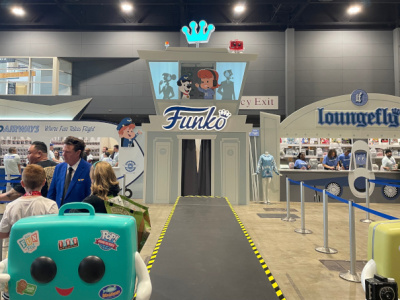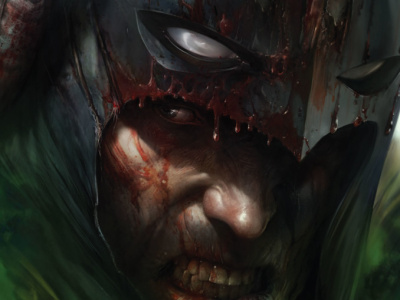
We were hearing at New York Comic Con that sales in comic stores were up on titles other than DC’s in September. That’s interesting for a couple of reasons: one is what it tells us about the kinds of people that were visiting comic stores; the second is what it took for that to happen. On the publisher side, we heard that sales were up on September comics from more than one mid-sized comic publisher. IDW was one of those. Here’s what IDW COO Greg Goldstein said about the sales of the company’s comics during the launch of DC’s New 52.
You’ve been telling us that IDW has had some big successes over this period [New 52 launch]. What are those?
Yes, September turned out to be a great month for us, starting actually in late August and continuing through where we are now, which is early October. We had the Teenage Mutant Ninja Turtles launch, and we actually sold out of Turtles #1 twice. It started to feel like old Turtles, back in the day. And then we nearly sold out of Turtles #2. Both new Star Trek books, the Star Trek ongoing in the new universe that’s been created by Bad Robot, as well as the Star Trek/Legion crossover had good initial orders. We overshipped slightly to Diamond to have extras for reorder, but even that was not enough. Certainly we’re all excited about that. Even Ghostbusters #1, which is a great book, tremendously funny and fun to read, sold out as well.
Yes, September turned out to be a great month for us, starting actually in late August and continuing through where we are now, which is early October. We had the Teenage Mutant Ninja Turtles launch, and we actually sold out of Turtles #1 twice. It started to feel like old Turtles, back in the day. And then we nearly sold out of Turtles #2. Both new Star Trek books, the Star Trek ongoing in the new universe that’s been created by Bad Robot, as well as the Star Trek/Legion crossover had good initial orders. We overshipped slightly to Diamond to have extras for reorder, but even that was not enough. Certainly we’re all excited about that. Even Ghostbusters #1, which is a great book, tremendously funny and fun to read, sold out as well.
What do you attribute that to?
I think there are a couple of reasons. I’d like to say that the main reason is that these are all great books, and we’ve had a terrific end of year line up. The reality is the DC New 52 brought some people into comic book stores that hadn’t been in comic stores for a while, and we had the opportunity to sell them some of our books as well as the other books that are available to them. But clearly, people who had not been focused on comics came out of the woodwork a bit.
I think there are a couple of reasons. I’d like to say that the main reason is that these are all great books, and we’ve had a terrific end of year line up. The reality is the DC New 52 brought some people into comic book stores that hadn’t been in comic stores for a while, and we had the opportunity to sell them some of our books as well as the other books that are available to them. But clearly, people who had not been focused on comics came out of the woodwork a bit.
And IDW went FOC [Final Order Cut-off, which allows retailers to alter their orders closer to print date] recently, and that meant that retailers who could see PDF’s of our books or some of the later marketing materials had an opportunity to increase their orders as we were going to press.
Here at ICv2, we note that IDW publishes the kinds of books that would appeal to fans that aren’t in comic stores every week: titles based on or known for other media. Goldstein mentioned TMNT, Star Trek, and Ghostbusters, all large properties in film and television. These were also new title launches, which irregular shoppers could get into easily without trying to reconstruct a storyline from past months to get involved. Retailers that prominently displayed media tie-in books, launches and self-contained works over the last few months probably gave themselves a better opportunity to take advantage of an influx of more buyers less committed than the usual hardcore Wednesday crowd.
We also feel it’s important to comment on the seasonality of the New 52 launch, the over-all trends, and what that tells about the impact of the New 52. September is traditionally the second worst month in comic stores (after February), as consumers focus on new cycles of school or work, summer titles have come and gone (and often left behind some unwanted inventory in their wakes), and publisher releases lag between the strongest summer and holiday titles.
This year, comic store sales trends were especially negative, with sales of the Top 300 Comics and Top 300 Graphic Novels down every month between October 2010 and August 2011, when Justice League #1 was released.
So for the comics market (as measured by sales on the top 300 comic and graphic novel titles) to have posted a 12.9% increase (or larger, see “Top 300 Shows Less Growth in August”) in August and a 7.4% increase in September took a much larger push than the numbers would indicate. Sales in comic stores over the last three months before August (May through July) had averaged over a 10% decline. And the seasonal impact is negative in September. By our calculations, that makes a roughly 10% average increase over the previous year during August and September explainable only with a 20% bump from the previous run rate of 10% decline, without any seasonal effect. If you throw in a normal drop-off in September from the previous months, the effect of the New 52, not only on DC’s sales but on over-all sales, may have been on the order of a 25-30% increase over what would have otherwise occurred.
The next few months will tell the tale of how many of the new/lapsed consumers that have visited comic stores over the past two months will continue to come back month after month, not only to pick up the DCs they tried out during the company’s relaunch, but also to pick up titles from other publishers. The stakes for the comic business are huge.







